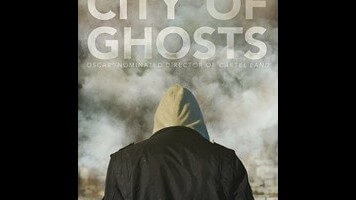The wave of revolutionary protests known as the Arab Spring occurred relatively early in the history of social media, less than five years after Twitter—a key factor in popular uprisings in countries like Egypt and Tunisia—was launched in summer 2006. Now that the Arab Spring has chilled into the Arab Winter, social media continues to play a key role in resistance to extremism in the Middle East, with both sides using increasingly sophisticated methods to win hearts and minds. This existential war of ideas is the subject of City Of Ghosts, the new documentary from Cartel Land director Matthew Heineman. The film profiles Raqqa Is Being Slaughtered Silently, a collective of mostly anonymous Syrians who risk their lives smuggling information out of the small city where ISIS has set up its headquarters and posting it online.
Our introduction to the conflict in Syria is relatively brief—those looking for a comprehensive look at the recent history of the country should read up first—and filtered through our protagonists’ nostalgia for the happy, carefree lives they lived there before fear and violence came to dominate their everyday existence. Gradually, those images are replaced by real (and really brutal) images of jihadists cutting off hands, whipping dissenters, and executing prisoners in the streets, captured on grainy cellphone videos by citizen journalists. With ISIS deliberately cutting off Raqqa from the rest of the world, most of the footage from the city is non-professional in origin—although, remarkably, Heineman either went there or smuggled in equipment for an interview with an anonymous source who appears about halfway through the film.
Although sorrow over what’s happening in Syria hangs restlessly over the film, most of City Of Ghosts was shot in either Turkey or Germany, where the core members of the group have been forced to flee after publicly revealing their identities. There, they live in a purgatory of Facebook messages and surreptitiously uploaded video, watching their lives fall apart, sometimes literally—at one point, one group member and his wife see footage of their street back home in ruins—while holed up in temporary housing in strange cities. Mediating these personal tragedies through laptops and cellphone screens creates a tragic sense of being nowhere at all; another member sends regular messages to his deceased brother on Facebook, and a third watches a video of his father being beheaded by ISIS whenever he feels his strength wavering. They spend their days waiting for the phone to ring, and the news is never good.
However, the anonymous RBSS members still stuck in Syria give the men a feeling of purpose, even as they fear that the Raqqa they know and love is gone forever. And the worse it gets, the more important it is to keep going. Being abroad doesn’t mean the members of RBSS are safe, and during the course of filming a man named Naji Jerf is assassinated in Turkey, the second person to die for their involvement with the group. ISIS continually stalks the core RBSS group that comes together in Germany after Jerf’s death both on- and offline, sending them pictures taken outside their apartment buildings and producing slick videos calling upon the faithful to kill them in the name of Allah.
In recent years, ISIS has deliberately modernized its recruitment efforts; gone are the grainy beheading videos of years past, replaced by slick, professionally produced commercials with the aesthetics of American blockbuster filmmaking. (One video, comparing jihad to a real-life video game, is disturbingly similar to U.S. Army commercials with the same theme.) It’s also extended its recruitment efforts to children; in a film filled with images of real-life death and destruction, one of the most devastating clips shows a preschool-aged child cutting a teddy bear’s throat as adults cheer for him offscreen.
Heineman poignantly weaves together these big-picture themes with intimate events in the group members’ lives, for example juxtaposing the child soldier mentioned above with one member meeting his newborn son. This tactic creates a feeling of profound empathy for RBSS’ plight, showing them as ordinary people—one member got involved simply because he was fascinated with cameras—who carry extraordinary burdens. There are many moving scenes in City Of Ghosts, but towards the end of the film one especially powerful sequence shows a RBSS member shaking uncontrollably as he thumbs through a stack of pictures of his friends, dead and alive. Earlier that day, he declined an offer of protection from German police, putting on a Star Wars T-shirt and a brave face and telling them, “I’ve overcome [the] fear” of being killed for his work. That sort of bravery in the face of real danger—in his hometown, bodies are hung in the public square with signs labeling them “media activists”—is a powerful reminder of how essential freedom of the press really is, and how easily it can be taken away.

